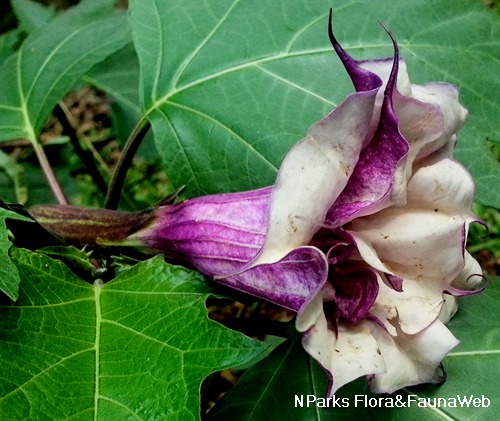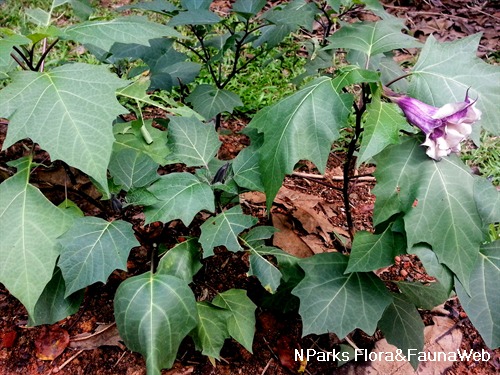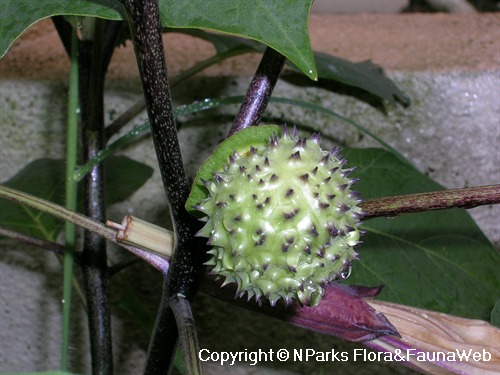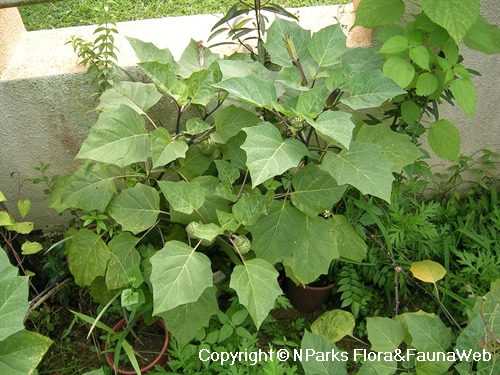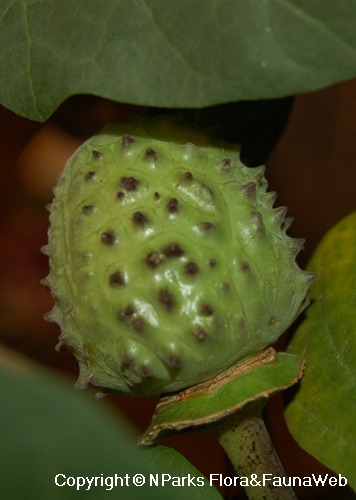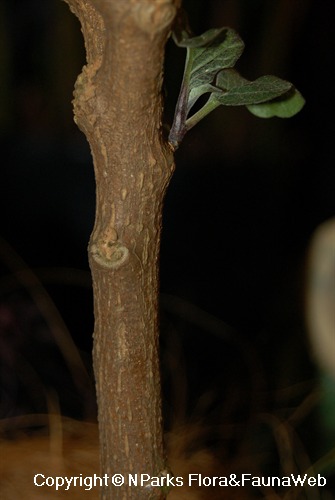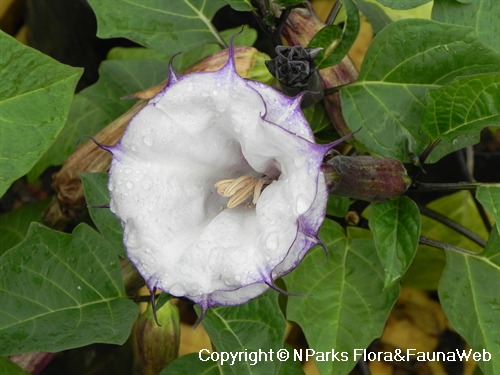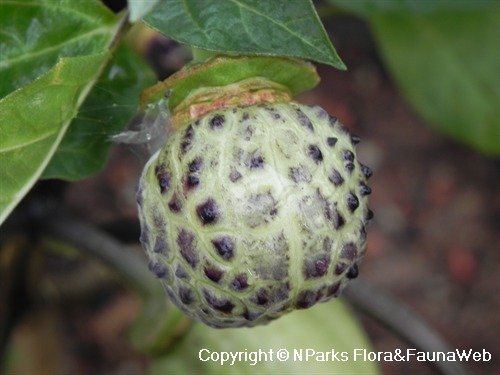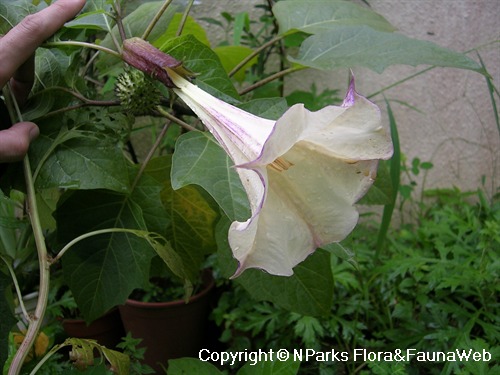
Back
Datura metel L.
| Family Name: | Solanaceae |
| Synonyms: | Datura humilis, Datura fastuosa, Datura alba, Datura fatuosa var. alba, Datura chlorantha |
| Common Name: | Horn of Plenty, Downy Thorn-Apple, Hoary Thorn-Apple, Purple Thorn-Apple, Thorn-Apple, Devil's Trumpet, 洋金花 |
Name
Classifications and Characteristics
| Plant Division | Angiosperms (Flowering Seed Plants) (Dicotyledon) |
|---|---|
| Plant Growth Form | Shrub |
| Lifespan (in Singapore) | Perennial |
| Mode of Nutrition | Autotrophic |
| Maximum Height | 0.5 m to 1.5 m |
Biogeography
| Native Distribution | Southern China |
|---|---|
| Native Habitat | Terrestrial (Riverine, Grassland / Savannah/ Scrubland) |
| Preferred Climate Zone | Tropical, Sub-Tropical / Monsoonal |
Description and Ethnobotany
| Growth Form | Medium-sized, evergreen woody shrub when grown in the subtropics or tropics. |
|---|---|
| Foliage | Leaves ovate (15 - 20 cm long) with undulate or serrate leaf margin. The leaves emit a disagreeable odor when bruised. |
| Flowers | Flowers are single, trumpet-shaped and held vertically (20 - 25 cm long). Short projections occur between adjacent lobes and heart-shaped notches occur in the middle of each lobe apex. Those growing in the wild are typically whitish, but there are purple cultivars. Flowers are most fragrant at night to attract pollinating sphinx moths. Cool nights promote flowering. |
| Fruit | Round to egg-shaped fruit is covered in tubercles (small, round bumps). It is classified as a capsule, a dry, dehiscent fruit. The fruit breaks open in an irregular manner, releasing 200 - 300 brownish yellow seeds. Seeds are approximately bean-shaped and have a large, whitish elaiosome. The elaiosome is a nutrient-rich tissue that attracts ants which disperse seeds. |
| Habitat | Occurs in grasslands, brushwood, forests dominated by teak and along rivers. Typically found at altitudes of up to 2100 m. |
| Cultivation | This species is fast-growing; it can grow 1 m within several months. Plant in a sandy soil that has good drainage. They have limited tolerance to drought. Indoor plants should be grown in a large pot (> 0.3 m wide) and fed biweekly. They are likely to reach 1 m in height. They are usually resistant to pests and diseases, but are susceptible to spider mites under dry growing conditions and root fungal diseases under wet conditions. In wet climates, plant this species in drier parts of the garden (eg., partly sheltered areas) to prevent root disease. |
| Etymology | The genus "Datura" comes from the Hindi name of Datura stramonium (dhatura), commonly known as Jimsonweed in English. This species is sometimes called "Angel's Trumpet," but this term is usually used for Brugmansia spp. |
| Ethnobotanical Uses | Medicinal: An extract of the flowers is said used as anaesthetic while the seed oil is used for massaging painful body parts. Others: An extract of the roots is sprinkled in houses to repel snakes. The seeds when mixed with sorghum flour are used as poison bait for rats. |
Landscaping Features
| Landscaping | This species is grown for its large, fragrant blossoms. The various parts of this plant species are toxic, especially the seeds. Avoid planting it in landscapes where pets and children are likely to encounter it. |
|---|---|
| Desirable Plant Features | Ornamental Flowers, Fragrant (Flowers) (Night, Day) |
| Landscape Uses | Flowerbed / Border, Container Planting |
| Thematic Landscaping | Moonlight Garden, Fragrant / Aromatherapy Garden |
| Usage Hazard - Cons | Toxic Upon Ingestion |
| Plant & Rootzone Preference or Tolerance Remarks | Sandy soil |
Fauna, Pollination and Dispersal
| Pollination Method(s) | Biotic (Fauna) (Insects (Butterfly, Moth)) |
|---|---|
| Seed or Spore Dispersal | Biotic (Fauna) (Insects (Ant, Beetle)) |
Plant Care and Propagation
| Light Preference | Semi-Shade |
|---|---|
| Water Preference | Moderate Water |
| Plant Growth Rate | Fast |
| Rootzone Tolerance | Well-Drained Soils |
| Maintenance Requirements | Moderate |
| Diseases | Spider mites, root fungal diseases |
| Propagation Method | Seed, Stem Cutting |
Foliar
| Foliage Retention | Evergreen |
|---|---|
| Mature Foliage Colour(s) | Green |
| Prominent Young Flush Colour(s) | Green |
| Foliar Type | Simple / Unifoliate |
| Foliar Arrangement Along Stem | Alternate |
| Foliar Attachment to Stem | Petiolate |
| Foliar Shape(s) | Non-Palm Foliage (Ovate) |
| Foliar Venation | Pinnate / Net |
| Foliar Margin | Entire - Wavy / Undulate, Serrate / Toothed |
| Foliar Apex - Tip | Acute |
| Foliar Base | Rounded / Obtuse |
| Typical Foliar Area | Mesophyll ( 45cm2 - 182.25 cm2 ) |
| Leaf Area Index (LAI) for Green Plot Ratio | 4.5 (Shrub & Groundcover - Dicot) |
Non - Foliar and Storage
| Mature Bark Texture | Lenticellate |
|---|---|
| Stem Type & Modification | Woody |
| Root Type | Underground (Tap Root) |
Floral (Angiosperm)
| Flower & Plant Sexuality | Bisexual Flowers |
| Flower Colour(s) | Purple, White |
|---|---|
| Flower Symmetry | Radial |
| Individual Flower Shape | Trumpet-shaped |
| Flower Size - Remarks | 20 - 25 cm long |
| Flowering Period | Free-Flowering |
| Flowering Opening Time | Night (dusk to dawn) |
| Flower Lifespan on Plant | 1 Night |
| Flowering Habit | Polycarpic |
Fruit, Seed and Spore
| Mature Fruit Colour(s) | Brown |
|---|---|
| Mature Fruit Texture(s) | Thorny / Spiny |
| Fruit Classification | Simple Fruit |
| Fruit Type | |
| Mature Seed Colour(s) | Brown |
| Seed Quantity Per Fruit | Numerous (>20) |
Image Repository
Others
| Master ID | 628 |
|---|---|
| Species ID | 1923 |
| Flora Disclaimer | The information in this website has been compiled from reliable sources, such as reference works on medicinal plants. It is not a substitute for medical advice or treatment and NParks does not purport to provide any medical advice. Readers should always consult his/her physician before using or consuming a plant for medicinal purposes. |

